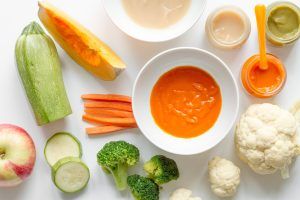Versatile Vegetable Purees
We’ve all been there. You bought too many carrots or cooked too much broccoli. Your family will only eat so much of one vegetable, particularly if it is cooked the same way. You don’t want to throw out perfectly good food. If you’ve got a blender, immersion blender, or food processor, you’ve got options. Chances are, your fridge is filled with versatile vegetable purees waiting to happen.
When most people hear the phrase “pureed vegetables” they think baby food. However, the fact is, if you’ve ever eaten mashed potatoes or cooked pumpkin – you’ve eaten pureed veggies. Unlike juicing, pureed veggies retain their fiber. Depending on how you’ve cooked them originally, they might have retained much of their nutritional value as well. Baking, grilling, roasting, steaming, or sautéing are good methods for retaining nutritional value, and bringing out the flavor of any veggie.
Uses
Too often we can’t think beyond mashed when it comes to extra or leftover veggies. The fact is, pureeing is healthy – and it’s a flavorful time saver in the kitchen. Pureed vegetables – of any kind – can be used:
- As a sandwich spread (think peppers and tomatoes)
- As a base for past sauces
- To thicken soups or used as a pureed soup on their own with just a little additional seasoning of fresh herbs
- To bind casserole ingredients
- As an addition to pan sauces
- As a moisture addition to baked goods
- As a meatloaf addition to add moisture to chicken and turkey loafs)
- As a garnish
- As a smoothie addition
- As a dip
Depending on which veggies you’re using – or combining – the possibilities are endless.
Make too much puree and can’t use it all at once? Freeze in ice cube trays for anytime you need a quick boost of flavor.
The Process
Make sure you’re veggies are cooked. Raw just won’t work. Chances are you’ll need to add a liquid during the puree process. Water, broth, juice, milk or cream, cooking juices from meat, even tea will create the desired consistency while adding to the flavor. Still need more flavor? You can add a fat like butter, olive oil, or coconut milk or seasonings like herbs, spices, hot sauce, vinegar, and soy sauce. Get creative! Have fun!
Caution
Just remember, watery veggies don’t always make the best puree. Be sure to seed tomatoes first. The more watery lettuces aren’t usually a good choice. Something to keep in mind!
- SHARE THIS POST








